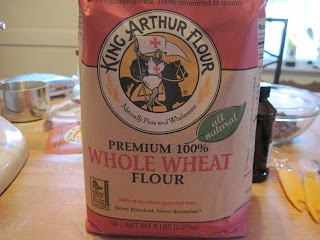We begin with our subjects in this experiment. The two wheat flours, sea salt, unsalted butter, baking soda, baking powder, chocolate chips (the original recipe called for chopped chocolate but you work with what you have), white sugar, dark brown sugar, eggs, and vanilla. For the sake of brevity, all common steps will come first.

Batch A was made with the White Whole Wheat Flour
It might be hard to see a major difference from this picture but the flour in the measuring cup is bleached white flour, for comparison with the white whole wheat. Whereas the bleached white flour is snow white, white whole wheat has a light brownish cast to it.

Here's the same comparison with the red whole wheat

See all the little flecks in this flour? That's the stuff that's good for you!

We sift our dry ingredients together (flour, salt, baking soda, baking powder). I do own a sifter but I find that a fine mesh strainer works just as well and is easier to clean.

This next step was a little different. This particular recipe called for creaming cold butter with the sugars. Most recipes, like the famous Toll House one, call for using softened butter. I typically use melted butter in my chocolate chip cookies, a trick I learned from my sister which makes them spread more and get the thin chewy texture I desire. I decided not to buck convention this time and follow the recipe as told.



I have no clue how I got this weird trippy photo. In case it is hard to tell, I added vanilla.

Add in the dry ingredients...


You have me taking a pic of them in the oven, having forgotten to before I threw them in. I will say that this dough definitely lent itself to needing to be formed into balls then flattened. I have my doubts that they would've flattened on their own. 

Here's the red wheat dough...pre-baking obviously

The white wheat cookies all baked.

The red ones all baked.

Here's a side by side comparison. No idea why this photo rotated itself upon upload...

I decided to use blind taste testers to compare the two cookies. I gave my wife Joanna, and our two friends Amber and Anthony, each a cookie from the respective batches. I didn't tell them what the difference was. I merely said I wanted to know which one they liked better and why.
So, what's the verdict?
Universally, the red whole wheat cookies were the winner. All three said they had a greater depth of flavor, a kind of subtle nuttiness, as well as seeming to have more amplified flavors, ie. they were more rich and buttery. The last comment was the most interesting as the recipes were identical beyond flour. The white whole wheat cookies were rated highly as well and, when I revealed the differences, we all agreed the white wheat could easily pass for being made with bleached flour. I will, therefore, be further experimenting with how far I can take the white whole wheat to bleached flour subbing.
I made whole wheat brownies last night, but that's another post...


